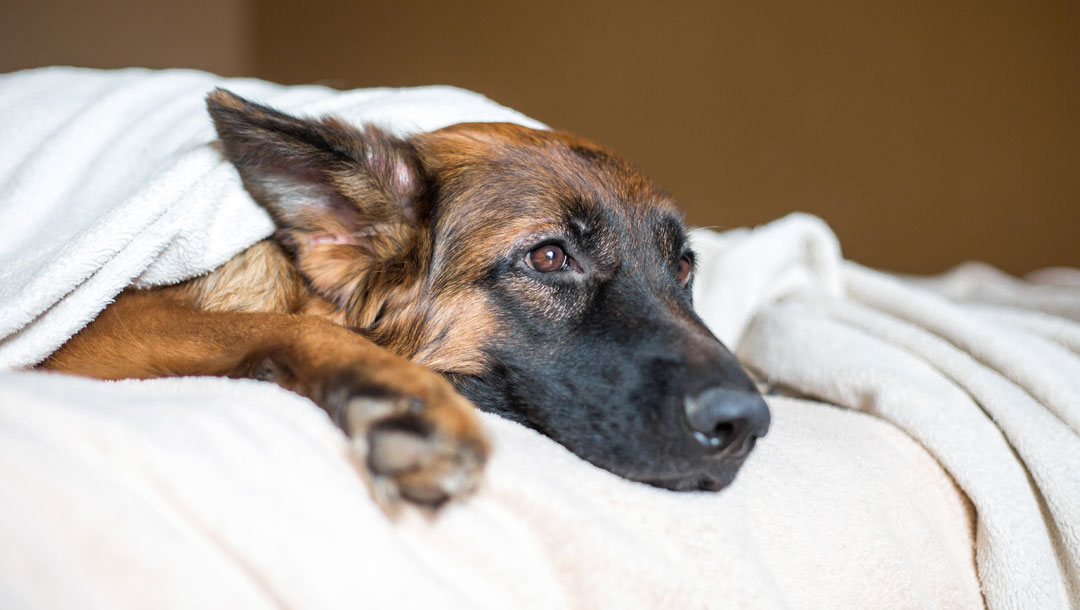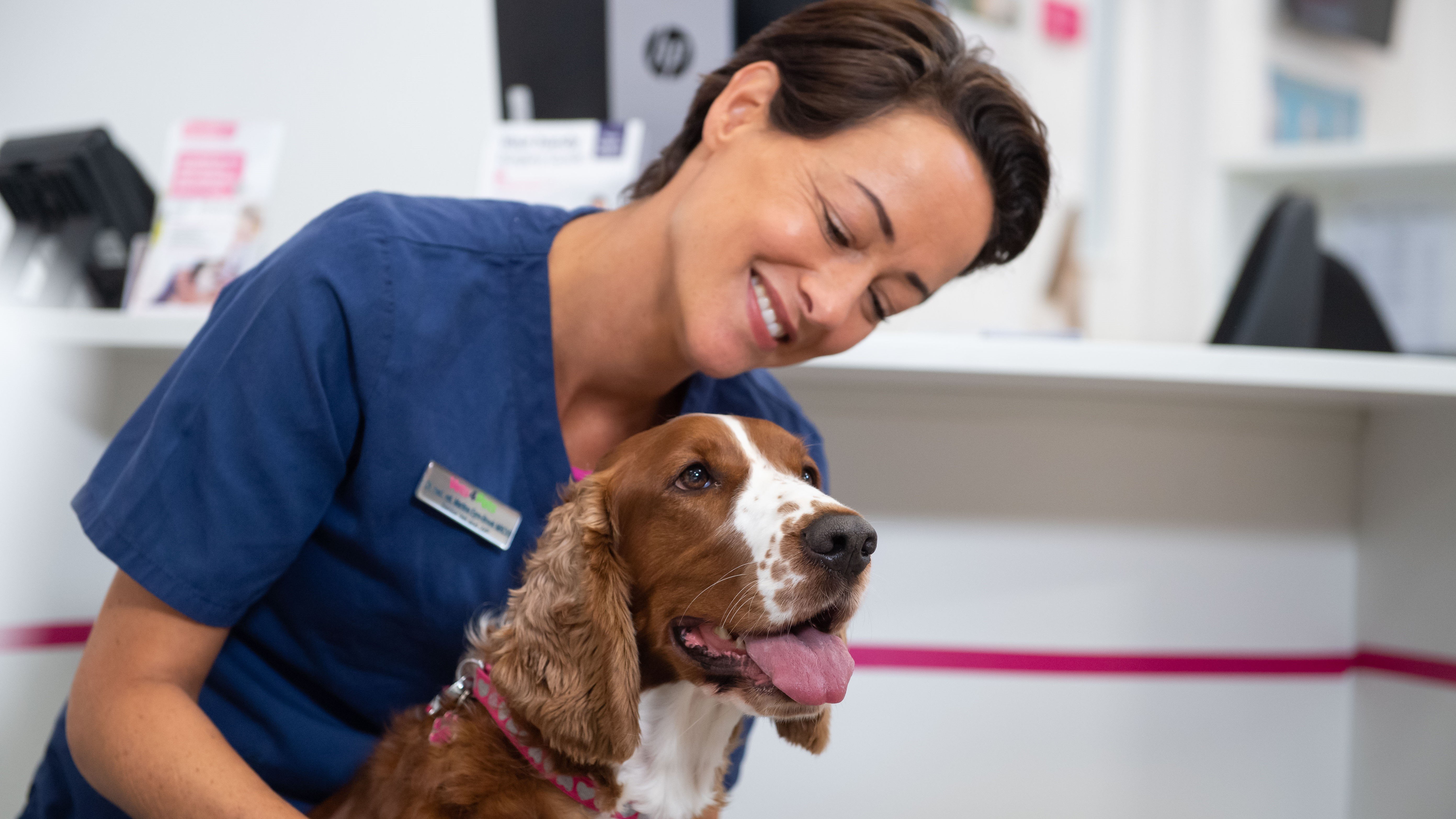
Ringworm in dogs
This common fungal infection can be uncomfortable and itchy for your beloved household pet - learn about the symptoms and how to treat ringworm in dogs.
Ringworm is an infectious disease that affects many types of animals, including dogs, cats, guinea pigs, horses and even humans.
It’s got nothing to do with worms, though: ringworm is a fungal disease, caused by micro-organisms called dermatophytes, which give the condition its other name – dermatophytosis. The name ‘ringworm’ comes from the appearance of the lesions on the skin of people, where reddish rings of dry, scaly, itchy skin surround a central area of recovering skin. On animals, the lesions can have many different appearances and can mimic other skin conditions.
So, how does your dog catch ringworm, what are the symptoms, and how do we treat ringworm in dogs?
Symptoms and signs of ringworm in a dog
It can take up to three weeks from your dog becoming infected before you notice symptoms on them. Dermatophytes feed on hair, nails and dead skin cells. They infect one hair shaft then, gradually, all those surrounding it. This leads to raised, crusty bumps around hair follicles, and alopecia (hair loss), progressing outwards from the originally infected follicle. Sometimes, large areas of alopecia develop as infected hairs break off. In severe cases, the whole body can become affected.
If your dog catches ringworm, you might notice these bumps with your fingers when you’re stroking them, or bare patches could begin to appear on your dog’s skin. Dermatophytosis can make dogs itchy, so you may see your dog scratching or licking themselves. As the infection progresses, new hairs grow in the follicles that were previously affected. Some dermatophytes can infect dogs’ foot pads and nails, causing nails to grow deformed, or to become brittle and break.
In healthy dogs, once the fungus reaches living tissue, this becomes inflamed, immunity starts to develop and infection begins to recede. This process can take weeks, however, and in the meantime an infected dog sheds large numbers of spores into the environment, risking transmission to people and other animals. The good news is that, once a dog recovers from ringworm, they are normally resistant to further infection for some time.
How is ringworm diagnosed?
Ringworm can resemble other skin conditions that cause inflamed hair follicles in dogs, including bacterial infections and mite infestations. If you spot hair loss or crusty, scaly or inflamed skin on your dog, it’s important that your vet checks them as soon as possible.
Your vet may recommend some diagnostic tests, most of which can be done during the consultation, to find out what’s going on. Your vet may recommend plucking some hairs and scraping some skin from suspicious lesions to view under the microscope. A small brush is used to sample material from lesions, which is then placed into a special growth medium. Your local clinic may keep fungal test kits in stock, but samples may be sent to an external laboratory.
Sometimes, dermatophytosis lesions have an atypical appearance. Perhaps initial testing hasn’t revealed a diagnosis, or treatment has already been tried, unsuccessfully. Your vet might recommend a skin biopsy be performed to discover the underlying cause. This is normally carried out under a short general anaesthetic or under sedation with local anaesthesia.
If your vet is suspicious that your dog has ringworm affecting their nails, they can send off nail clippings to the laboratory for fungal culture.
Treatment for ringworm in dogs
Although healthy dogs normally recover from dermatophytosis by themselves, this can take weeks. The ringworm infection can be transmitted to other pets and people, so prompt treatment and environmental management are always recommended. Treatment falls into two categories: topical (surface) and systemic (oral).
Topical treatment for canine ringworm
It’s recommended that all dogs with dermatophytosis receive topical therapy. Topical treatment reduces shedding into the environment, helps to prevent new lesions from developing and kills spores. Occasionally, some of the affected hair may need to be trimmed away using scissors, to make it easier to treat the ringworm lesions. Your vet will let you know how often to bathe your dog using fungicidal shampoo but, typically, it’s carried out twice a week.
Medicated shampoo doesn’t have a persistent effect, so additional, daily treatment is normally recommended. This could be in the form of leave-on mousses, which are easy to use around the face and ears.
Always wear gloves and follow the label’s safety instructions when you’re handling medicated treatments.
Systemic treatment for canine ringworm
Your vet may prescribe oral medication as well as topical therapy because this attacks the ringworm infection within the hair follicles.
Bacterial skin infections can resemble ringworm and the two often occur together. If your vet has identified bacterial involvement, they may also prescribe antibiotics as part of your dog’s treatment.
If anyone in contact with your dog develops unusual patches on their own skin, they should show their doctor and mention that they’ve been near to a dog with ringworm.
Once your dog’s ringworm lesions have healed and the test is negative, your vet will need to make sure the infection is truly cleared. This is normally done by submitting two fungal cultures, one week apart, once your dog has completed their treatment and is healthy.
Environmental management of ringworm in dogs
You’ll need to do an initial deep clean of everywhere your dog has been, including your home and vehicles.
Fungal spores can be removed by wiping hard surfaces with detergent. Household cleaners, including some bathroom products and others containing hydrogen peroxide, may be anti-fungal and might state this on the label.
- Bowls and toys can be scrubbed in hot, soapy water
- Bedding and any washable soft furnishings can be decontaminated by vacuuming (provided the vacuum cleaner has a filter and is cleaned and emptied afterwards), followed by two machine washes, using normal laundry detergent on a long cycle
- Deep cleaning like this should be performed twice a week, while regular vacuuming, washing and wiping down need to be repeated daily, to ensure that any further infected hairs are removed from the environment as quickly as possible
- To decontaminate carpets, two treatments using a carpet cleaner, or one steam-clean, should be adequate
It will help to minimise environmental contamination – and cleaning – if you confine your affected dog to one room while they’re undergoing treatment. You’ll still be able to interact with them so they don’t feel left out – just wash your clothes afterwards and avoid direct contact with your dog’s skin. You can wear disposable gloves and use hand sanitiser or wash your hands after spending time together. Use washable toys, leads, collars, feeding equipment and bedding and don’t share those with other pets.
Ringworm is commoner in young dogs, who can still carry on with socialisation, play and training outdoors, provided they don’t have close or direct contact with other pets or people.
Pets who have been in direct contact with an infected dog can be bathed with an antifungal shampoo and monitored closely for signs of ringworm developing.
FAQs
Ringworm is a contagious skin disease caused by a group of fungi called dermatophytes, that feed on the proteins in hair, nails and dead skin. Some dermatophytes only infect one animal species, while others can be passed between species, including transmission from pets to humans. In dogs, a fungus called Microsporum canis (M canis) is responsible for round 70% of cases, while a further 20% are caused by Microsporum gypseum and the remaining 10% by Trichophyton mentagrophytes (which is the main cause of ringworm in guinea pigs).
Dogs can catch ringworm either by direct contact with an infected animal or person, or from the environment. Dermatophytes produce thousands of arthrospores, microscopic, infectious particles that can survive in the environment for approximately 18 months. If a dog encounters sufficient numbers of spores on furniture, soil, bedding or grooming equipment, or from touching another animal, an infection can gain access. The infection becomes more likely if the dog’s skin is scratched or damaged. Some strains of dermatophytes seem to cause more severe symptoms than others, and it’s impossible to predict which ones these will be.
Some dogs are particularly susceptible to becoming infected. Dogs who don’t have fully competent immune systems, for instance, young puppies, old dogs and those under physiological stress can be affected more severely and can be more difficult to treat successfully.
Dogs have skin all the way from the tip of their ear flap to their eardrum. If a dog is exposed to ringworm spores in the environment, for instance, by digging or walking in contaminated soil, and they scratch at their ear, the spores can gain access to the ear.
Skin trauma caused by scratching can make it easy for the infection to take hold. Dogs who already have ringworm lesions on their skin can also develop it in their ears as the infection spreads.
The good news is that many of the medicated drops we prescribe for use in ears contain a fungicidal ingredient, so these can be used to treat ringworm in dogs’ ears, along with the other measures to treat and control the infection.
Hair loss is one of the signs of ringworm in dogs. When the dermatophytes infect hair follicles, they invade the hairs themselves, weakening them and causing them to break off at the base. This leads to bare patches on your dog.
Once your dog starts to become immune to the infection and the follicles produce new hairs, the bare patches disappear again.
Several other conditions can cause hair loss in dogs, so it’s important that your vet examines your dog if you notice this symptom.
Health Plans to keep your dog healthy
At Vets4Pets we offer a range of Health Plans that make essential routine treatments more affordable. You'll save money on things like annual vaccinations, flea and worm treatment and routine health check-ups.

Dog Advice
Read more of our expert dog advice to keep your dog happy and healthy.
